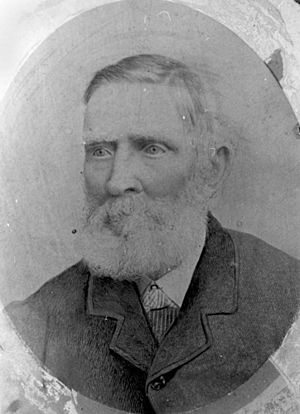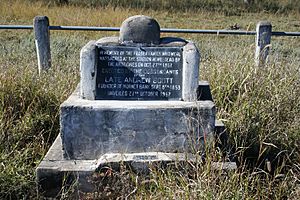Fraser family grave site and memorial, Hornet Bank facts for kids
Quick facts for kids Fraser family grave site and memorial, Hornet Bank |
|
|---|---|

Fraser family grave site and memorial, Hornet Bank, 2008
|
|
| Location | Hornet Bank Station, Hornet Bank Road, Eurombah, Shire of Banana, Queensland, Australia |
| Official name: Fraser family grave site and memorial, Hornet Bank | |
| Type | state heritage (archaeological, built) |
| Designated | 18 September 2008 |
| Reference no. | 602075 |
| Significant period | 1850s |
| Lua error in Module:Location_map at line 420: attempt to index field 'wikibase' (a nil value). | |
The Fraser family grave site and memorial at Hornet Bank is a special historical place in Queensland, Australia. It includes a cemetery and a memorial. This site is located at Hornet Bank Station, near Taroom, and is listed on the Queensland Heritage Register. It remembers a sad event from 1857 when eleven settlers, including eight members of the Fraser family, lost their lives at the station.
Contents
History of Hornet Bank Station
Hornet Bank Station is in the upper Dawson River area. Andrew Scott started the station in 1853. Today, his family still owns the main homestead. In 1857, a tragic event happened here. Local Aboriginal people attacked the station, leading to the deaths of eleven settlers. Eight of these were members of the Fraser family, who were managing Hornet Bank for Andrew Scott. This event deeply affected the people living in the area and changed relationships between European settlers and Indigenous people in Queensland for many years.
Early European Settlement
Friedrich Wilhelm Ludwig Leichhardt was the first European explorer to visit the upper Dawson River area in 1845. He wrote great reports about the rich land, which attracted settlers. Within two years, European settlement began. Andrew Scott was one of the first settlers. He claimed the first parts of Hornet Bank in 1853.
Scott was born in Scotland in 1810 and came to Australia in the late 1830s. He learned about farming at his future father-in-law's property in the Hunter Valley of New South Wales. In 1853, he applied for a lease along the Dawson River. The Aboriginal name for the area was Gaganybilany. Scott supposedly named it Hornet Bank after being stung by a swarm of hornets there.
The Fraser Family at Hornet Bank
In March 1854, John Fraser, a Scotsman, became the manager of Hornet Bank for Andrew Scott. He moved there with his wife, Martha, and their children. John Fraser had worked as a bookkeeper at Jimbour Station before this.
In May 1856, John Fraser became ill and died while moving sheep to Ipswich. Mrs. Fraser decided to stay at Hornet Bank. Her oldest son, William, who worked as a carrier in Ipswich, came back to help his family. However, William often had to leave the station for his business, sometimes for months.
The 1857 Tragedy
Around this time, tensions grew between the local Jiman (or Yeeman) Aboriginal people and the settlers along the Dawson River. Several incidents happened in 1856 and 1857. Hornet Bank was the most western station, making it an easy target. In late October 1857, William Fraser was away, leaving the station less protected.
On the morning of October 27, 1857, the attack occurred. Eleven people at the station died, including eight members of the Fraser family. All of the Fraser family victims were women and children. The only survivor was Sylvester Fraser, who was 15 years old. The victims were buried on the property.
After the Tragedy
The Hornet Bank tragedy caused a strong reaction among settlers. It led to more conflict in the Dawson and Burnett areas. Many Aboriginal people were killed during this time. Fighting continued in the Dawson River area until about 1870.
Despite the tragedy, Andrew Scott kept Hornet Bank Station. In 1860, he married Christina Brodie. They did not live permanently at Hornet Bank until the violence had calmed down. In the mid-1860s, Andrew Gordon managed the station. During this time, new timber slab buildings were added to the main station area. Scott's father-in-law, Robert Brodie, a stonemason, is thought to have built many of these structures before he died there in 1867.
The house where the Fraser family lived was later used as a store after a new homestead was built around 1865. The original house was described as a typical bush hut with a verandah, a bark roof, and three rooms. By 1916-1917, the original homestead from 1857 had been removed and replaced with a more modern house.
When Andrew Scott died in 1892, his sons took over Hornet Bank.
The Grave Site and Memorial
The Fraser family grave site is about 250 meters northwest of the main Hornet Bank home area, near a waterhole. A fence made of metal rails marks the site. Inside the fence, there are no individual graves or headstones visible.
In the middle of the fenced area, there is a concrete memorial with three steps. It has a plaque that reads:
In memory of the Fraser family who were massacred at the station homestead by the aborigines on October 27th 1857.
Erected by the descendants of the late Andrew Scott, founder of Hornet Bank September 8, 1853. Unveiled 27th October 1957.
A small metal plaque at the bottom of the memorial also says:
Hugh T Scott & J Hamilton, Builders
This memorial was put up in October 1957 to mark 100 years since the tragedy.



